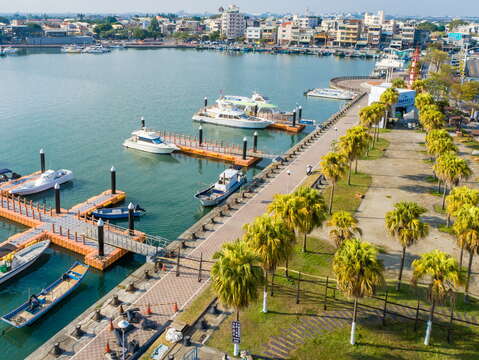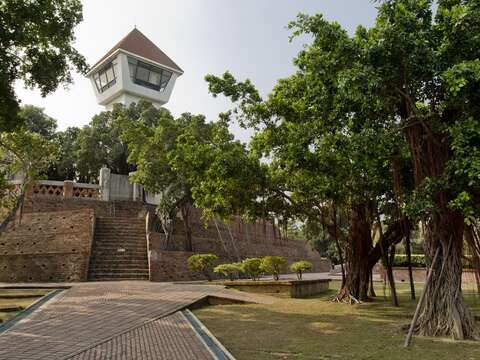Old Tainan City Remains (Fort Zeelandia Interior Wall)(臺灣城殘蹟(安平古堡內牆))
Updated:2024-06-05
9106
Introduce
The Dutch built the Orange city in 1622. Upon the completion in 1640, the city was renamed Fort Zeelandia, including the inner and the outer forts. The inner fort is a three-story square building, with the basement as a warehouse and a bastion at each of the four corners on the upper level of the two above-ground floors. Between each two corners there are the north, east, and south gates. On the lintel of the north gate, the words T'CASTEEL ZEELDIA GEBOUWED ANNO 1634 (Fort Zeelandia Built 1634) are inscribed. A bastion was also built at each corner of the lower level, with a semicircular barrack in the middle of the sides of the foundation, and a well at the center of each semicircular barrack.
In the north there is a small gate and a stairway leading to the underground magazine. There are battlements on both the lower and upper levels, on the protruding bastions there are watchtowers and turrets, and each bastion is equipped with five cannons The entire fortress is bonded with mortar made with glutinous rice juice, syrup, sand, and powered oyster shells. Today, a few sections of the city wall and a semicircular bastion survive, and the scale of the remains of the Anping Old Fort is the largest.
After the Portuguese discovered the route from Europe to the Far East via the Cape of Good Hope (Cabo da Boa Esperança) in the late 15th century, western (European) powers began their eastward movement. First, the Portuguese occupied Macao and set consulates along the southeastern coast of China. Then Spain followed suit, and Japan the next. The Dutch wishing to have trade with the Ming Empire was thus under extreme pressure.
In the late 17th century, the Dutch invaded Penghu twice, but all were defeated by the Ming Empire. In September 1623, Admiral Cornelis Reijersen led his troops build a facility at Anping Harbor. The Dutch troop demolished the facility after withdrawing from the place as the Ming Empire fought back to Penghu. In July 1624, the Dutch occupied Taiwan, with Martinus Sonck appointed the first governor, and built a fortress on the old fortress foundation in Yikunshen. In lack of bricks, they built the fortress with sandy soil and other materials and called the place the Orange city. In 1627, they renamed it Zeelandia and progressively changed the materials into bricks. The outcome completed on January 1, 1633 was the beginning of Taiwan City (also called the King’s City, Chihkan City, Anping City) . As the city was built by the Dutch, early Han people called it the “red hair city” because they called the Dutch “red hair”. After the reconstruction during Japanese colonization, the city has been called Anping Old City until today.
In 1661, Cheng-kung ZHENG expelled the Dutch from Taiwan and migrated to Zeelandia. That’s why the city is also called the King’s City. In 1683, Taiwan became part of the Qing dynasty, and the King’s City lost its position and became a naval facility. The city wall was collapsed by a magazine explosion in 1871. As the city has lost its value as a military facility after the explosion, Qing official Bao-zhen SHEN massively disassembled the bricks and rocks of Taiwan City to build the Erkunshen Battery (Eternal Golden Castle today) in 1874. By that time, only ruins remained in Taiwan City. To build the Anping Customs Officers Quarter, the Japanese colonial government built a tall platform on the ruins in 1897. After building western buildings on the platform, they changed the name of the place as Anping Old City. By that time, the original Taiwan City extinguished, except for one ruined city wall standing there witnessing this part of Taiwan’s history. (Shih, 1999:48). According to the restoration made by Shunichi Kuriyama in 1936, it seems that there are the inner and outer walls at the corner (outer) city. In addition, besides the said section, there were five more ruined sites of the outer city.
At the L-shaped area around Gubao Street, Guosheng Road, Land 85 of Anping Road, and Anbei Road, there are six sections of suspected ruins of Taiwan City.
One section hidden behind the civilian residences at Nos. 71, 73, 75, 77, and 79 of Guosheng Road runs parallel to Guosheng Road. This 2m-tall, 38.7-m long, 2m-thick wall with a 2m-wide and 1.5m tall door opening is supposed to the ruin of the northern outer city wall (K.E. Cheng Architect & Associates, 1993:100). The second (0.5m thick) and third sections about 1.5m long and 2.7m tall without known separation hide at No. 67 Guosheng Road and the enclosure wall of the coffin store connected to it. The fourth section about 15.15m long and 5.4m tall of unknown thickness with a trapezoidal shape (narrower top and wider bottom) is located behind the Xilong Temple, and it is suspected to be the ruin of the south bastion west of the corner (outer) city. The fifth and the sixth sections are separated. The fifth one about 7.63m long, 1.81m tall of unknown thickness stands between the northern enclosure wall of the Anlong Temple and No. 67 of Guosheng Road. On the wall there is a calabash-shaped door opening. However, the size of the bricks and the mortar bonding them suggest that this may not be the ruin of Taipei City. The sixth section about 3.18m long, 2m tall, and 0.32m thick is located at the outer enclosure wall off No. 75 Guosheng Road. Most part of it is covered by planters, and its overall shape is unidentified. In conclusion, the ruin is packed between two residences separated by a small seam impassible for measurement of any kind, and further investigation is required.
In September 2001, the Tainan City Government implemented the “Anping Harbor National Historical Park” project. In the non-destructive inspection with ground-penetrating radar performed before project implementation, they found many inner-city sites and conducted an academic historical and archaeological research with fruitful results by integrating architectural, civil engineering, and archaeological technologies. In September 2004, the Tainan City Government included related outer-city sites as “city historical sites” called the “Zeelandia City Wall & Inner-City Buildings Historical Site” for preservation and maintenance. The “Hall Side Watchtower” is a modern building. Looking afar from the tower, we can almost see the coast. Recollecting the Ming troop landing on Luermen, the Dutch Fort Zeelandia in Beixianwei (Bassemboy), or the engagement of the troops of both countries at Redoudt Zeeburch. The merit of Cheng-kung ZHENG has become eternity.
Anping Minor Artillery Fort
The fort is located west of the Taiwan City ruins, and its enclosure stone dike is long and narrow running from the south to the north. The artillery fort includes the fort structure and the enclosure stone dike in the north. Sitting next to the Shuici Park, the fort is made with granite and pebbles with six brick battlements in the south, north, and west sites, with fort floor built with oil-surface bricks. A magazine is in the basement. The fort was originally equipped with the British B.P. 9-pound shell muzzle-loading cannon. The cannons we see today are not the original ones. The stone dike in the north side is built with the coral stone bonded with cement. The loopholes on the surface are equipped with valves to block water. The front section of the dike runs deep inside civilian residences and link to other civilian residences via the open space of the community activity center in the local district. The rear section is the stone dike of the old fort across from the plaza, low civilian buildings, a church, forming a natural defense system with the fish farms in the west.
Information
TEL +886-6-2267348
Address No. 82, Guosheng Rd., Anping Dist., Tainan City Taiwán, R.O.C
Category Culture
Open Hours Mondy~Thursday: 8:30-17:30
Friday ~ Sunday(Holidy): 8:30-20:00
Charge Full price tickets NT$70, half price tickets NT$35
(Free entry for Tainan residents with IDs)




